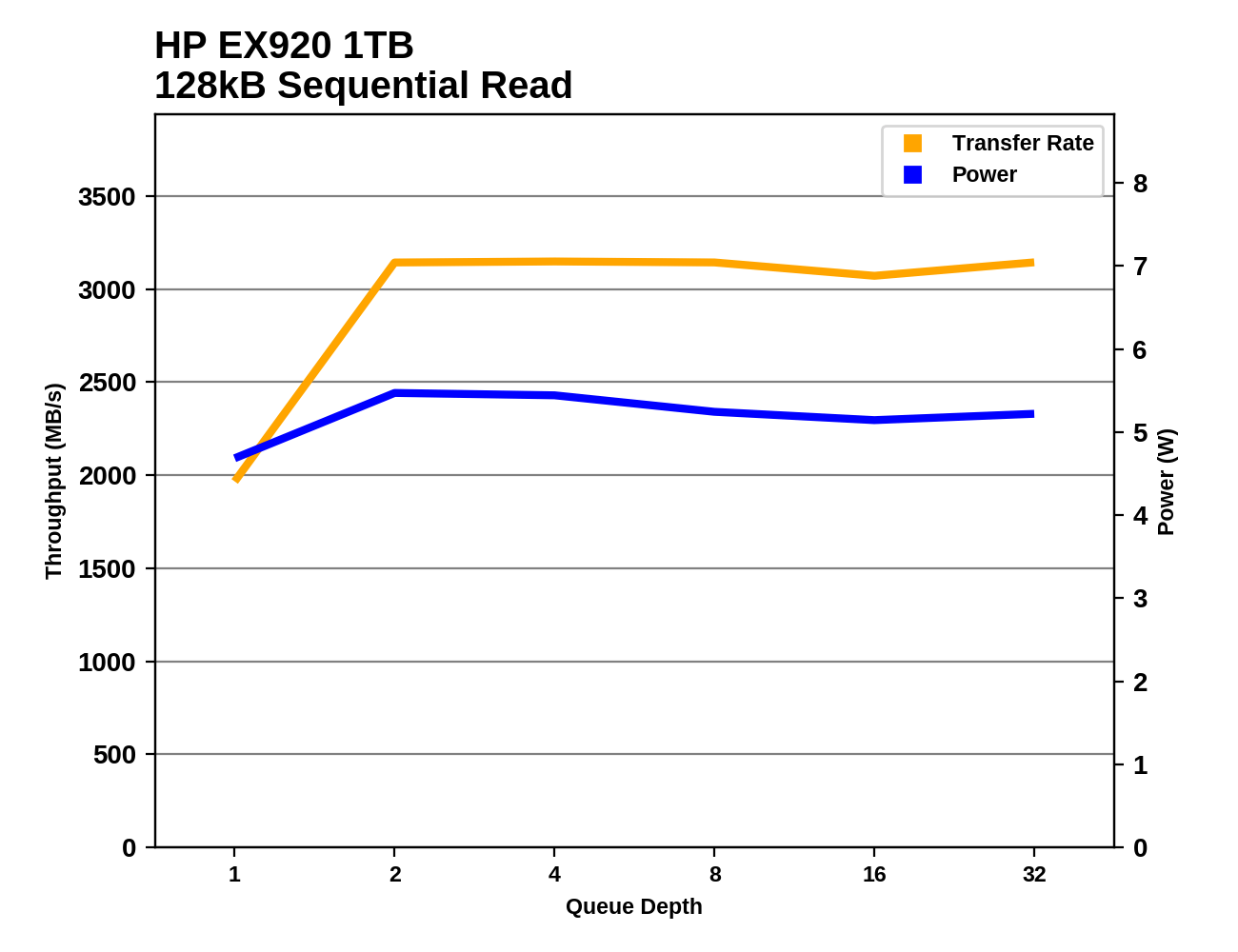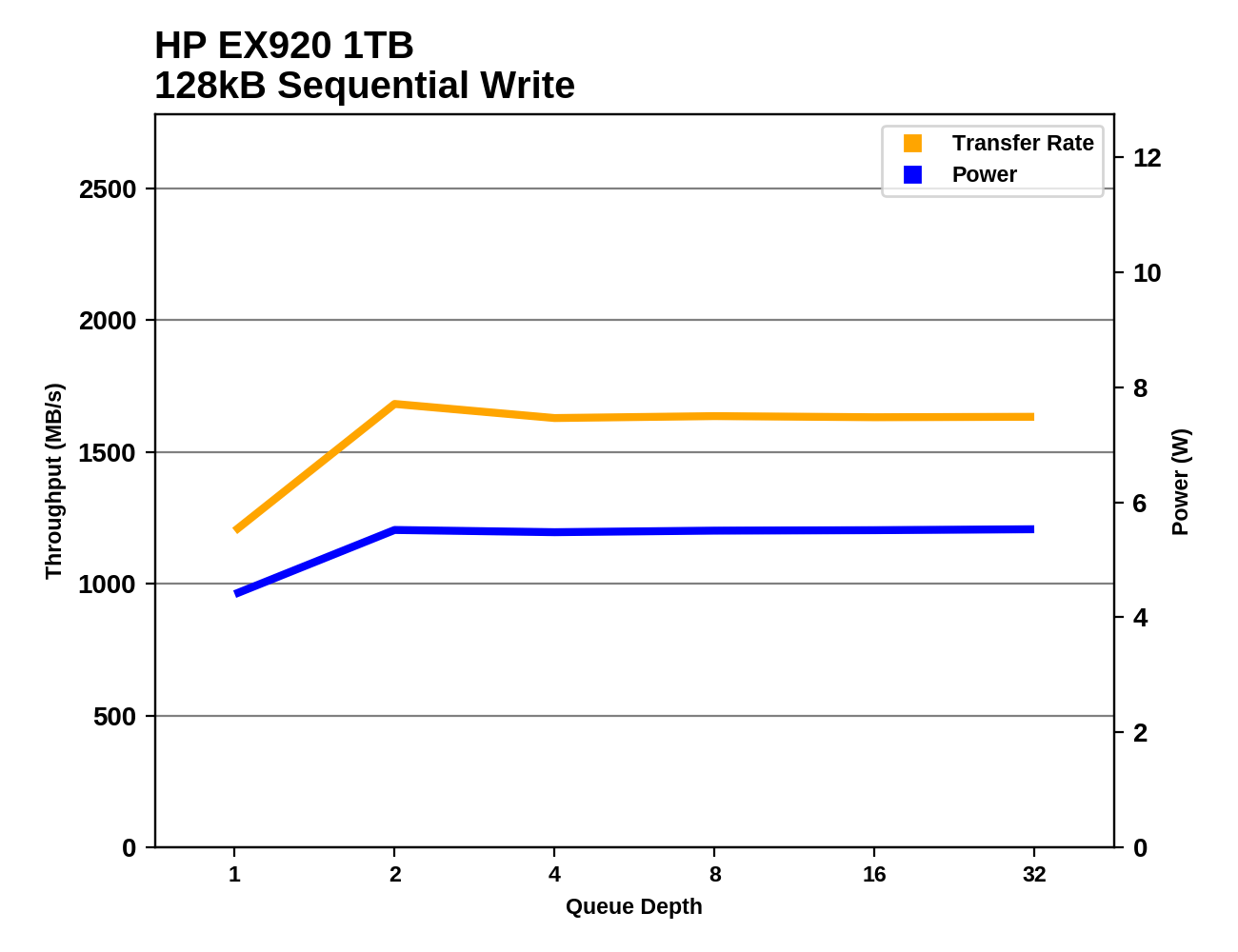The HP EX920 M.2 SSD Review: Finding the Mainstream Sweet Spot
by Billy Tallis on July 9, 2018 9:00 AM ESTSequential Read Performance
Our first test of sequential read performance uses short bursts of 128MB, issued as 128kB operations with no queuing. The test averages performance across eight bursts for a total of 1GB of data transferred from a drive containing 16GB of data. Between each burst the drive is given enough idle time to keep the overall duty cycle at 20%.

The HP EX920 breaks another record by delivering burst sequential read speeds of almost 2.5GB/s, when no other TLC-based SSD we've tested has yet hit 2GB/s on this test. The EX920 is even beating the MLC and 3D XPoint-based drives on this test.
Our test of sustained sequential reads uses queue depths from 1 to 32, with the performance and power scores computed as the average of QD1, QD2 and QD4. Each queue depth is tested for up to one minute or 32GB transferred, from a drive containing 64GB of data. This test is run twice: once with the drive prepared by sequentially writing the test data, and again after the random write test has mixed things up, causing fragmentation inside the SSD that isn't visible to the OS. These two scores represent the two extremes of how the drive would perform under real-world usage, where wear leveling and modifications to some existing data will create some internal fragmentation that degrades performance, but usually not to the extent shown here.

On the longer sequential read test with higher queue depths, the Samsung 960 PRO catches up to the EX920 and Samsung's TLC-based competitors come close. However, this only applies to a clean drive and data that was written sequentially. When the data has been fragmented by random writes, the sequential read speed of the EX920 drops by a lot, leaving it merely average and much slower than the Samsung drives (or the Optane SSD that is immune to this form of fragmentation).
 |
|||||||||
| Power Efficiency in MB/s/W | Average Power in W | ||||||||
With such high sequential read performance on a clean drive, it's no surprise to see the HP EX920 near the top of the efficiency chart, even though the drive is pulling more than 5W. On fragmented data the EX920 ends up worse off than any drive that isn't using a Silicon Motion controller, because the sequential read speed tanks while power consumption remains about the same.
 |
|||||||||
The HP EX920 gets up to speed very quickly, reaching full sequential read speed at QD2 when several high-end NVMe SSDs require quite high queue depths to deliver their best performance. The EX920 is eventually surpassed by numerous competitors, but at low to mid queue depths it is definitely the fastest.
Sequential Write Performance
Our test of sequential write burst performance is structured identically to the sequential read burst performance test save for the direction of the data transfer. Each burst writes 128MB as 128kB operations issued at QD1, for a total of 1GB of data written to a drive containing 16GB of data.

The burst sequential write speed of the HP EX920 is great, but it is overshadowed a bit by the large lead Samsung's 970 EVO has on this test.
Our test of sustained sequential writes is structured identically to our sustained sequential read test, save for the direction of the data transfers. Queue depths range from 1 to 32 and each queue depth is tested for up to one minute or 32GB, followed by up to one minute of idle time for the drive to cool off and perform garbage collection. The test is confined to a 64GB span of the drive.

On the longer sequential write test, the HP EX920 falls a bit further behind as the scores of the top-tier drives are a bit more spread out than for the burst test. The EX920 is still providing performance that is worthy of a high-end NVMe SSD, but it can't match Samsung or WD.
 |
|||||||||
| Power Efficiency in MB/s/W | Average Power in W | ||||||||
The power efficiency of the HP EX920 on the sustained sequential write test is good, but several drives deliver higher performance while drawing less power, and the 970 EVO offers substantially higher performance with only slightly higher power draw. The most efficient drive is still the Toshiba XG5, which performs the same as the EX920 on this test but draws only 3W while the EX920 requires more than 5W.
 |
|||||||||
Like almost all drives in this class, the EX920 shows very consistent performance across most of the test duration, with the only hint of SLC write caching effects showing up in the slight drop in performance after QD2. The Toshiba XG5 is the most notable exception, as it takes a bit longer to get up to speed.










32 Comments
View All Comments
DanNeely - Monday, July 9, 2018 - link
The same ignorant rage about SSD costs that the clueless have been spouting for the last decade.0ldman79 - Monday, July 9, 2018 - link
The numbers can all be skewed if you change how you measure them.How much does 1 gram of sand cost? A bit of PCB? Copper tracings?
Gotta ignore the labor, R&D, foundries, etc...
That's like the genius fixing the giant machine for $2,000. Itemized invoice, $2 for turning the screw, $1998 for knowing which screw to turn.
philehidiot - Monday, July 9, 2018 - link
That's my job. It's easy but requires skills and knowledge.But they pay me bugger all.
Cliff34 - Monday, July 9, 2018 - link
They don't want to drop the price more because it will eat into their margin.That's how the ssd market is. Your lowest is the sata. With nvmd, it is a higher price points (same spec).
Of course they can drop the price, but why would they do that when they can make more per unit knowing that many people who buy nvm often don't have a choice for sata.
ATC9001 - Wednesday, July 11, 2018 - link
Exactly....I mean who wouldn't want to get a lot more performance for the same price as a consumer? If they stopped charging premiums there wouldnt be any money left over for R&D for what comes after nvm. Also, if you can afford these large SSD's I really don;t wanna hear whining about the price....talk about a first world problem.MrSpadge - Monday, July 9, 2018 - link
http://www.insye.com/DP/NANDFlashSpotPrice.aspxEven with 512 Gbit TLC chips (best price per capacity, slowest) the NAND alone will currently cost 9$/chip, i.e. 144$. And you need a bit more than that to build a SSD.
Samus - Monday, July 9, 2018 - link
$20 bucks LOL. Controllers alone cost nearly that!FullmetalTitan - Thursday, July 12, 2018 - link
The memory controller alone probably wholesales for ~$12-18, so I don't know where you are getting those numbers.Death666Angel - Monday, July 9, 2018 - link
"the flip side is that its pricing is noticeably lower than the flagships from more established SSD brands like Samsung and Western Digital." Unfortunately not true in Germany. :( Doesn't seem to be fully released here, 3 retailers offer it, but those 3 are large ones.Vanguarde - Monday, July 9, 2018 - link
These will sell like hot cakes if they put the 1TB out for $39.99